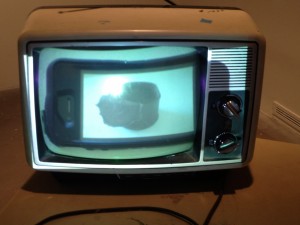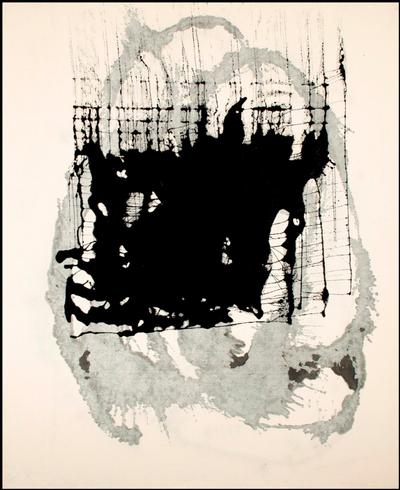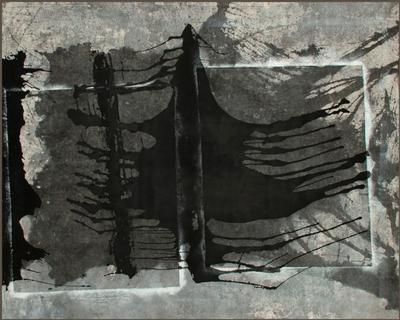
Santa Fe Art in Review: “Useless Things”, Canned Snow and Zachariah Reike
SFUAD BFA Thesis Show
Useless Things & Other Stuff, the SFUAD BFA Thesis show, opened on November 30th, with a solo show by Sandra Halpin who is the only graduate this semester from Santa Fe University of Art and Design’s BFA program. Halpin filled the Southwest Annex with four video installations, some Kool-Aid, a trough of goldfish and well, useless things.
Reporting as her classmate, Halpin’s studio was notoriously swallowed all semester by what most people would consider trash. But actually the artist was deep into repurposing these found objects. To show for it, the main gallery wall of Useless Things & Other Stuff shows a video explaining just how to use these useless things, among which are forgotten bras, skanky mattresses and more pomegranate juice bottles than the most antioxidant-aware consumer could stomach. The same three options prevail: “You can wear them as a hat,” explains Halpin and flips the camera around to reveal her jet-black bob stylishly sporting a deflated beige bra. “You could drive over them with your car, for fun!” Emphasis, on the fun part. The most fun of all? “If you’re really ambitious, you could make a carnival game out of them!” With the “simple toss of the ball,” that collapsed bra cup becomes the perfect pocket to catch a Ping-Pong ball. Placed contrastingly spare throughout the gallery are plastered-over POM bottles, a bucket of Ping-Pong balls, two stripped mattresses (just the springs) and a bag of long lost bras.

Another video titled Here’s the Thing projects onto an old television set, definitely a cultural signpost of a useless thing. The TV cord rests on the table, unplugged but still a surface for projection. “This is an iPhone image of a useless thing,” says Halpin. “But here’s the thing,” she continues, “This is not a useless thing. This is an iPhone image of a useless thing.” Useless Things & Other Stuff revisits the readymade with appreciated good humor.

SNOW POEMS
Site Santa Fe’s newest SPREAD winner, Edie Tsong, hosted her inaugural project Snow Poems (part of the Cut+Paste Society partnering with the Santa Fe Art Institute) event at Marji Gallery on December 2d. Snow Poems seeks to explore “cities as ‘living books’ written by their inhabitants.” Thinking of cities as living books may be a tricky concept but instead of having billboards or advertisements that mark the cityscape with text, imagine Snow Poems’ monochromatic banners of text and faux -snow. This non-toxic temporary spray snow will be used to stencil original poetry written by community members. Snow Poems is hosting a number of workshops to brainstorm for poetry. One or two lines will be chosen for each business, and will be visible in the windows of 25 local business here in Santa Fe.
 Attendees for their inaugural event last Sunday were asked to wear white–an act of solidarity? Many complied and pulling out those winter whites did help set the mood. Fifteen poets read original works or from selected texts and learned that there is a new use for poetry and for “canned snow.” White stenciled around letters casts interior shadows of carefully selected words. This reminder of sunshine and community in the dead of winter can only be fortifying. Naturally, Snow Poems is a winter project with all installations washed away by spring. Tsong and co. hope to expand to other cities but for now maintain focus here in Santa Fe.
Attendees for their inaugural event last Sunday were asked to wear white–an act of solidarity? Many complied and pulling out those winter whites did help set the mood. Fifteen poets read original works or from selected texts and learned that there is a new use for poetry and for “canned snow.” White stenciled around letters casts interior shadows of carefully selected words. This reminder of sunshine and community in the dead of winter can only be fortifying. Naturally, Snow Poems is a winter project with all installations washed away by spring. Tsong and co. hope to expand to other cities but for now maintain focus here in Santa Fe.
Everyone is invited to attend Snow Poem collaborative workshops to write poetry to be included. Workshops are happening now so click here for info! Open poetry submissions and donations can be made online.

ZACHARIAH RIEKE AT WADE WILSON
Wade Wilson Art‘s newest show of black-and-white paintings by Zachariah Reike is up until January 2, 2013. Reike works on the floor and from both sides of the canvas, leaving white and black gesso imprints that soak into the fibers. Painting 34 is 80” x 66” and shows large circular splotches in pale gray. They emerge from the black gesso on the underside where the severity of color leaves a pale residue on the front and provides a backdrop that feels distanced from the frontal image. This seeping is what Reike calls the “ghost image,” on top of which is a saturated black grid with whisper thin calligraphic lines trailing up. The grid collapses in the center where it is totally black, blotched like an ink spill. Rorschach tests are not far from thought and Reike’s work method certainly allows for a certain amount of interpretation.

Indebted to Taoism, Reike paints “without a lot of thinking” and without “trying to effect one particular look.” He pays attention to what he is doing and what the paint does, moving with it as needs be. Although his surfaces are smooth and the black and white gesso soak into the fibers seamlessly, sometimes Reike dries two canvases face to face only to unpeel them later. The effect is a thick painterly residue left by the opposing canvas’s paint. This is most evident in Painting 15 where an even darker black rests upon the surface of the otherwise absorbed black gesso. It seems then that Reike works with duality and the idea that what we see is in dialogue with surfaces that are hidden or removed and likewise, open for interpretation.

